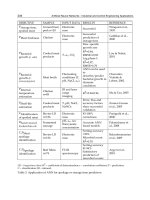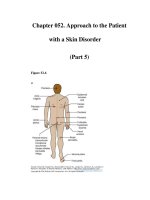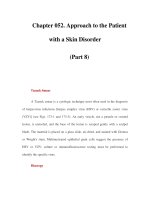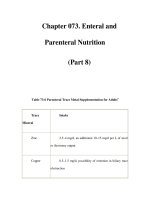Chapter 122. Acute Infectious Diarrheal Diseases and Bacterial Food Poisoning (Part 8) pptx
Bạn đang xem bản rút gọn của tài liệu. Xem và tải ngay bản đầy đủ của tài liệu tại đây (17.95 KB, 6 trang )
Chapter 122. Acute Infectious Diarrheal Diseases
and Bacterial Food Poisoning
(Part 8)
B. cereus can produce either a syndrome with a short incubation period—
the emetic form, mediated by a staphylococcal type of enterotoxin—or one with a
longer incubation period (8–16 h)—the diarrheal form, caused by an enterotoxin
resembling E. coli LT, in which diarrhea and abdominal cramps are characteristic
but vomiting is uncommon. The emetic form of B. cereus food poisoning is
associated with contaminated fried rice; the organism is common in uncooked rice,
and its heat-resistant spores survive boiling. If cooked rice is not refrigerated, the
spores can germinate and produce toxin. Frying before serving may not destroy
the preformed, heat-stable toxin.
Food poisoning due to Clostridium perfringens also has a slightly longer
incubation period (8–14 h) and results from the survival of heat-resistant spores in
inadequately cooked meat, poultry, or legumes. After ingestion, toxin is produced
in the intestinal tract, causing moderately severe abdominal cramps and diarrhea;
vomiting is rare, as is fever. The illness is self-limited, rarely lasting >24 h.
Not all food poisoning has a bacterial cause. Nonbacterial agents of short-
incubation food poisoning include capsaicin, which is found in hot peppers, and a
variety of toxins found in fish and shellfish (Chap. 391).
Laboratory Evaluation
Many cases of noninflammatory diarrhea are self-limited or can be treated
empirically, and in these instances the clinician may not need to determine a
specific etiology. Potentially pathogenic E. coli cannot be distinguished from
normal fecal flora by routine culture, and tests to detect enterotoxins are not
available in most clinical laboratories. In situations in which cholera is a concern,
stool should be cultured on thiosulfate–citrate–bile salts–sucrose (TCBS) agar. A
latex agglutination test has made the rapid detection of rotavirus in stool practical
for many laboratories, while reverse-transcriptase polymerase chain reaction and
specific antigen enzyme immunoassays have been developed for the identification
of norovirus. At least three stool specimens should be examined for Giardia cysts
or stained for Cryptosporidium if the level of clinical suspicion regarding the
involvement of these organisms is high.
All patients with fever and evidence of inflammatory disease acquired
outside the hospital should have stool cultured for Salmonella, Shigella, and
Campylobacter. Salmonella and Shigella can be selected on MacConkey's agar as
non-lactose-fermenting (colorless) colonies or can be grown on Salmonella-
Shigella agar or in selenite enrichment broth, both of which inhibit most
organisms except these pathogens. Evaluation of nosocomial diarrhea should
initially focus on C. difficile; stool culture for other pathogens in this setting has an
extremely low yield and is not cost-effective. Toxins A and B produced by
pathogenic strains of C. difficile can be detected by rapid enzyme immunoassays
and latex agglutination tests (Chap. 123). Isolation of C. jejuni requires inoculation
of fresh stool onto selective growth medium and incubation at 42°C in a
microaerophilic atmosphere. In many laboratories in the United States, E. coli
O157:H7 is among the most common pathogens isolated from visibly bloody
stools. Strains of this enterohemorrhagic serotype can be identified in specialized
laboratories by serotyping but also can be identified presumptively in hospital
laboratories as lactose-fermenting, indole-positive colonies of sorbitol
nonfermenters (white colonies) on sorbitol MacConkey plates. Fresh stools should
be examined for amebic cysts and trophozoites
Infectious Diarrhea or Bacterial Food Poisoning: Treatment
In many cases, a specific diagnosis is not necessary or not available to
guide treatment. The clinician can proceed with the information obtained from the
history, stool examination, and evaluation of dehydration severity. Empirical
regimens for the treatment of traveler's diarrhea are listed in Table 122-5.
Table 122-5 Treatment of Traveler's D
iarrhea on the Basis of Clinical
Features
Clinical Syndrome Suggested Therapy
Watery diarrhea (no
blood in stool, no fever), 1
or 2 unformed stools per
day without distressing
enteric symptoms
Oral fluids (Pedialyte, Lytren, or flavored
mineral water) and saltine crackers
Watery diarrhea (no
blood in stool, no fever), 1
or 2 unformed stools per
day with distressing enteric
symptoms
Bismuth subsalicylate (for adults): 30 mL or 2
tablets (262 mg/tablet) every 30 min for 8 doses; or
loperamide
a
: 4 mg init
ially followed by 2 mg after
passage of each unformed stool, not to exceed 8
tablets (16 mg) per day (prescription dose) or 4
caplets (8 mg) per day (over-the-
counter dose); drugs
can be taken for 2 days
Watery diarrhea (no
blood in stool, no
distressin
g abdominal pain,
no fever), >2 unformed
stools per day
Antibacterial drug
b
plus (for adults)
loperamide
a
(see dose above)
Dysentery (passage
of bloody stools) or fever
(>37.8°C)
Antibacterial drug
b
Vomiting, minimal
diarrhea
Bismuth subsalicylate (fo
r adults; see dose
above)
Diarrhea in infants
(<2 y old)
Fluids and electrolytes (Pedialyte, Lytren);
continue feeding, especially with breast milk; seek
medical attention for moderate dehydration, fever
lasting >24 h, bloody stools, or diarrhea lasting m
ore
than several days
Diarrhea in pregnant
Fluids and electrolytes; can consider
attapulgite, 3 g initially, with dose repeated after
women
passage of each unformed stool or every 2 h
(whichever is earlier), for a total dosage of 9 g/d; seek
medical attention for persistent or severe symptoms
Diarrhea despite
trimethoprim-
sulfamethoxazole
prophylaxis
Fluoroquinolone—with loperamide
a
(see dose
above) if no fever and no blood in stool, alone in
cases of fever/dysentery
Diarrhea despite
fluoroquinolone
prophylaxis
Bismuth subsalicylate (see dose above) for
mild to moderate disease; consult physician for
moderate to severe disease or if disease persists









